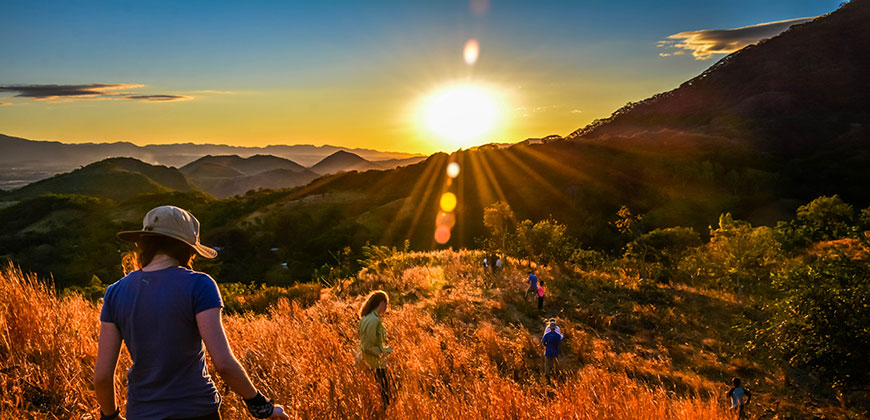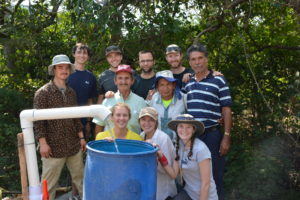
EWB-CSU students scope out the La Criba water tank site at sunset. Credit: Peter Field
Imagine not having immediate access to clean water, and having two choices: walk several miles to the river for unprocessed water, or pay a fifth of your monthly income to get a ride to the nearest clean water output.
This is the dilemma for the 750 residents of La Criba, El Salvador. Colorado State University engineering students are working to change that.
The CSU chapter of the international organization Engineers Without Borders (EWB-CSU) took on the La Criba water supply and distribution system as a project back in 2010, and are slated to finish later this year. Soon, there will be a distribution line running from La Criba’s main tank to each property boundary, providing each resident easy access to clean water.
Though a water distribution system was built in 1964, it had become insufficient due to population growth, material deterioration and seismic activity. On average, the people of La Criba earn only $50 per month.
In 2008, the Peace Corps visited La Criba to support residents on a variety of subjects, and to connect them with other nonprofit organizations. CSU-EWB was wrapping up a project in San Antonio Abad at the time. Recognizing La Criba’s need, Peace Corps volunteers helped the community apply for help from Engineers Without Borders (EWB).
Clean water for all
With philanthropic support from the Japanese Embassy and involvement from the municipality of Candelaria, EWB can send eight members at a time to help out with the project. “We’ve made two trips every year, in January and August, since June 2011,” said CSU civil and environmental engineering student and EWB-CSU grant writing lead Eric Molten.

Each trip has a different purpose, getting La Criba closer to clean water with every visit. “In 2011 the well was drilled, the pump and motor were installed in 2013, and the transmission line that takes water from the well to the tank was put in in 2015. The control system that allows the tank to communicate with the pump was just installed in January,” Molten said. And on trips in between, data is collected to streamline design processes back in the U.S.
Because each visit is only about two weeks, EWB cannot support every step of the installation process, but rather members provide technical support to the community and on-site partners. For their forthcoming trip in August, EWB plans to develop a manual for the community to learn how to run the water system, as well as a business plan. “The community asked us, ‘How do we charge?’ We have to teach them how to make the system sustainable,” said La Criba project lead Peter Field, a CSU mechanical engineering student.
Future projects for Engineers Without Borders
Once the project in La Criba is completed, EWB is required to provide support and be in contact with the community for two years. In the meantime, the student organization is laying the groundwork for two more projects: one to build a green community center for the Pine Ridge Indian Reservation in South Dakota, and another with the Todos Santos Center in Baja California Sur, Mexico.
EWB as an organization that strives for sustainability, providing solutions to communities that are both functional and enduring, and the CSU chapter is no exception. About his experience with EWB-CSU, Field said: “I like that there’s a strong sense of team spirit, and that you’re working with a bunch of people with the same goal, all working hard to accomplish a task that changes people’s lives.”
The future of EWB-CSU is not planned to end in South Dakota or Mexico. The CSU chapter aims to make a continuous global effort, and is always looking for support – through new members, new projects, and additional funding.